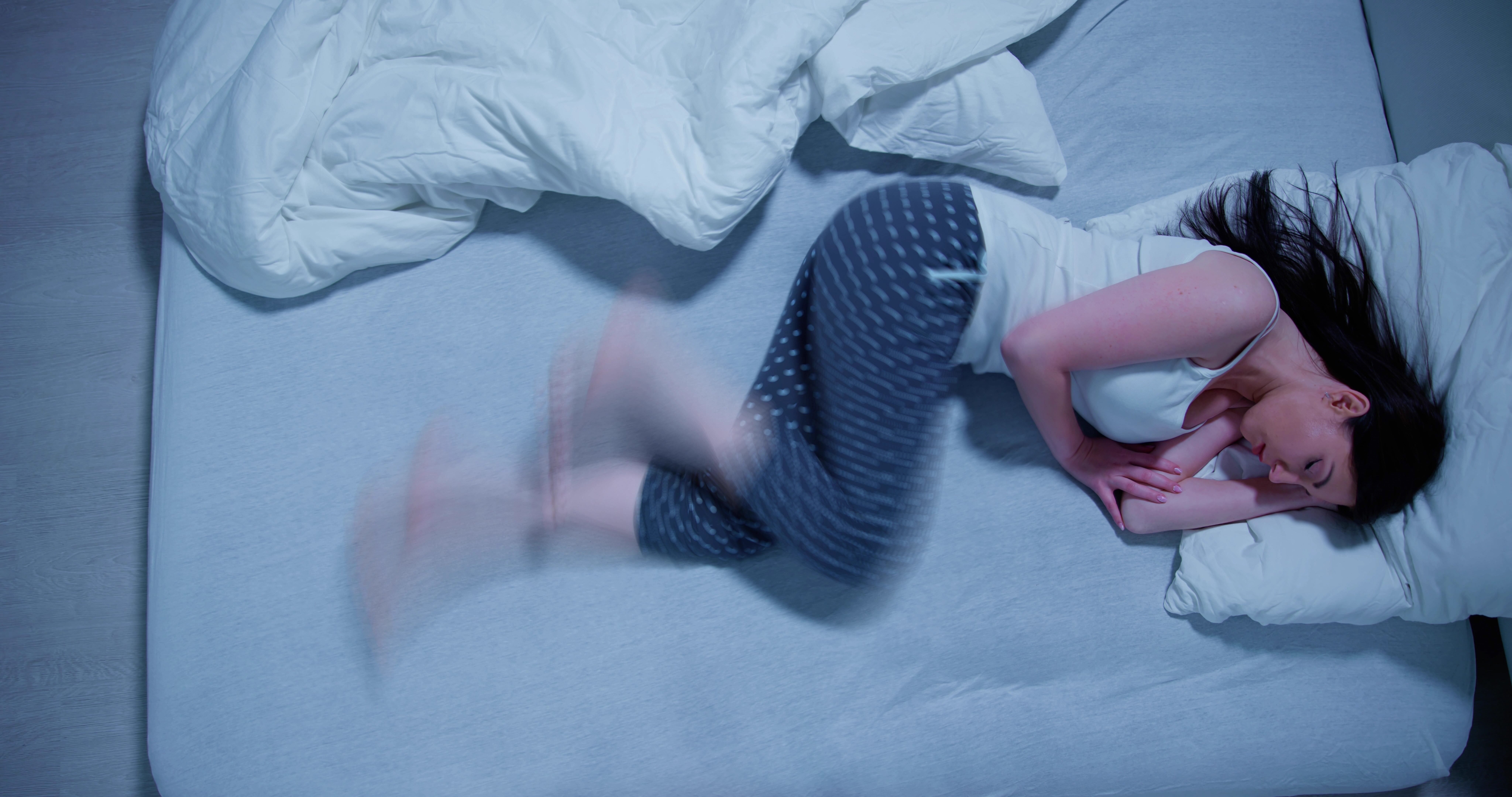Restless leg syndrome (RLS) causes uncomfortable sensations in the legs and a powerful urge to move. Sitting or lying down usually triggers it mostly in the evenings or at night. A way to temporarily feel better is to get up and move around.
Unfortunately, as you get older, RLS gets worse. These sleep disturbances can interfere with your daily life on so many levels.
Thankfully, the right treatment, life changes, and some self-care can help relieve symptoms of RLS leg pain in most patients.
Restless Leg Syndrome: Causes and Risks
In most cases, restless leg syndrome doesn’t really have a known cause. Some think a brain chemical called “dopamine,” which controls muscle movement, may be to blame for the condition.
The condition can also run in families, especially if it starts before the age of 40. A gene for restless legs may be present within certain chromosomes.
Symptoms can also be temporarily worsened by pregnancy or hormonal changes. RLS may strike for the first time during pregnancy, especially during the last trimester. After delivery, symptoms usually go away.
You can get RLS at any age, even as a child. The condition is more common in women as they age than in men. Extreme restless leg syndrome isn’t usually caused by anything serious. It can, however, come with other conditions:
- Spinal cord disorders: Injuries or damage to the spinal cord can cause restless leg syndrome. The risk of developing RLS is also higher if you’ve had any sort of anesthesia injected into your spinal cord.
- Kidney failure: Iron deficiency is often accompanied by anemia in people with kidney failure. Iron levels in your blood can drop if your kidneys aren’t working right. RLS may be caused or worsened by this and other changes in body chemistry.
- Peripheral neuropathy: Often, chronic diseases like diabetes and alcoholism cause nerve damage in both the hands and feet.
- Parkinson’s Disease: RLS is more common in people with Parkinson’s Disease and those who take a special compound that activates dopamine receptors in treatment of such (called dopaminergic agonists).
- Lack of iron: Even without any sort of anemia being present, iron deficiency can worsen or cause RLS. In some cases an iron deficiency may be caused by bleeding from the stomach or bowels, heavy menstrual periods, or donating blood too frequently.
The Bewildering Enigma of Restless Leg Syndrome
According to research, many Americans suffer from restless leg syndrome, along with a handful of sleep disorders or similar characteristics.
According to a 2020 research paper from the National Library of Medicine, 70 percent of American adults don’t get enough sleep at least one night a month, and 11 percent don’t get enough sleep every single night. On top of these facts about the general population, it’s good to note that:
- Jerking leg syndrome affects about 15 percent of the U.S. population.
- Because RLS has multiple causes and varies so much in response to treatments, it’s always been a challenge to manage.
- No matter your family history, you can get RLS at any age.
- Symptoms, causes, and implications for patients of “primary restless leg syndrome” and “secondary restless leg syndrome” can be similar, but there are some notable differences as well.
- Acupuncture, light therapy, repetitive transcranial magnetic stimulation, and transcutaneous spinal direct current stimulation can often largely reduce RLS symptoms.
- Kicking leg syndrome often occurs with another sleep disorder called Periodic Limb Movement of Sleep (PLMS), characterized by periodic episodes of repetitive, stereotyped leg movement during sleep. According to the studies, around 80 percent of people with RLS have PLMS. The movements associated with PLMS often consist of flexion or extension at the ankle. In some cases, this may also occur at the knee, or it may occur on one side, or go back and forth between the left and right sides.
Given these facts, the symptoms of restless leg syndrome are even more interesting.
Restless Leg Syndrome Symptoms
Leg twitching is the main symptom of restless leg syndrome. Restless sensations that often start while you’re sleeping characterize RLS. Most people get this feeling after lying down or sitting for a long time, like in a car or a plane.
Movement can also relieve symptoms. Stretching, shaking the legs, pacing or walking helps RLS leg pain symptoms. However, it’s also possible for symptoms to get worse in the evening. Nighttime leg twitching, unfortunately, can be a common symptom. It can be associated with periodic limb movement of sleep, which causes the legs to twitch and kick while you sleep, possibly all night long.
Symptoms of RLS include unpleasant sensations in the legs or feet. It will usually happen on both sides. Arms, however, are usually less affected. Nonetheless, symptoms include itching, pulling, crawling, throbbing, creeping, aching, and electric sensations, which generally happen inside the limb rather than on the skin. It may sometimes be hard to even explain the sensations. Patients consistently describe and report leg movement, but they do not typically report muscle cramps and numbness as symptoms.
The severity of symptoms from restless legs changes a lot. What’s even more interesting is, symptoms can disappear for a while before returning.
How to Alleviate the Symptoms
A sleeping disorder like restless leg syndrome can be made worse by personal habits. There may be times when they’re a big part of the problem. You can reduce symptoms and sleep better by trying some (or all) of the following tips, or go further by exploring RLS treatment. For now, the tips include:
- Massage your legs regularly.
- Get some exercise every day.
- Avoid napping during the day.
- Stretch your legs every morning and evening.
- Avoid using your bed for anything but sleeping or sexual activity.
- Request a blood test to evaluate how your kidneys and iron may be functioning.
- Do your best not to worry about anything at bedtime.
- Before going to sleep, avoid alcohol, caffeine, and nicotine.
- Always let your doctor know what medications you’re taking.
- Before going to sleep, soak your legs in warm water.
- Avoid eating a heavy meal before bedtime.
- Work on keeping a regular sleep schedule.
Consider severe RLS treatment when you have tried nearly everything possible in your own power to alleviate your restless leg syndrome.
When to See a Doctor for Restless Legs Syndrome
The fear of not being taken seriously makes some people never seek medical attention for restless leg syndrome. However, since RLS leg pain can interfere with your sleep and make you drowsy during the day, it is also affecting your quality of life. Get checked out by your doctor if you think you might have RLS.
If your diagnosis is positive, write down the name of the RLS treatment or test. Keep a note of any new instructions you get from your doctor. Make it a priority to know why you’re getting a new medicine or treatment. Also, make sure you know the side effects. You may wish to ask your doctor if there’s another way to treat your condition.
Know why you’re seeing a health specialist for RLS and what you expect from that visit. Make a list of questions you want answered before your visit. You may wish to have someone else present with you during the visit so they can help you remember what your doctor says.
Understand why a restless leg syndrome test or procedure is suggested and what the results mean. If you choose not to take the medicine or not to have a test or procedure, know what to expect. Make a note of your follow-up appointment date, time, and purpose. Make sure you know how to get in touch with your provider.
Wellness and Pain
When it comes to restless leg syndrome, it’s best to see a specialist or doctor who truly cares about your health. Oftentimes, our Wellness and Pain practitioners will recommend and offer radiofrequency ablation, which uses energy to heat inside the vessel walls, causing damaged vessels to close. We also use sclerotherapy to close off problem vessels with a foam that causes scarring. Injecting this foam into these vessels allows blood to flow to healthy ones.
Our services include vein ablation, massage therapy, acupuncture, and IV hydration. Wellness and Pain practitioners provide these important evaluations, apply their professional expertise, and offer the caring and sensitive RLS treatment you need.











